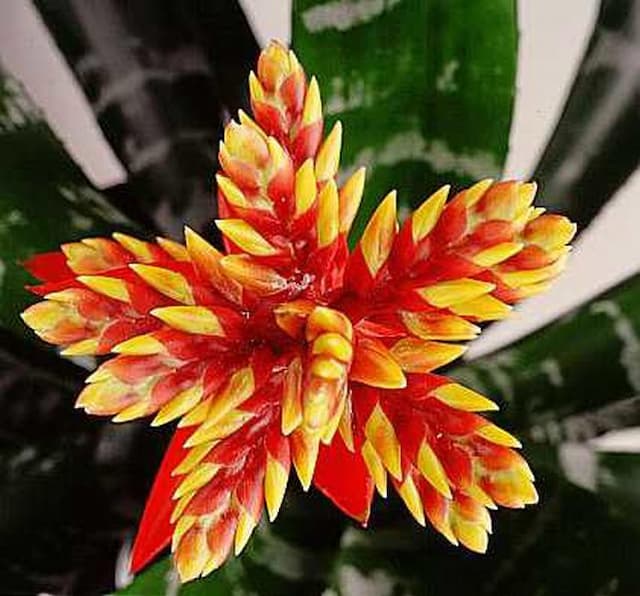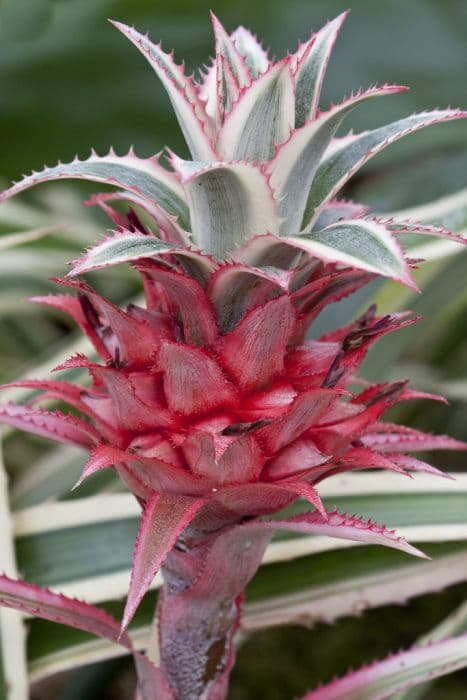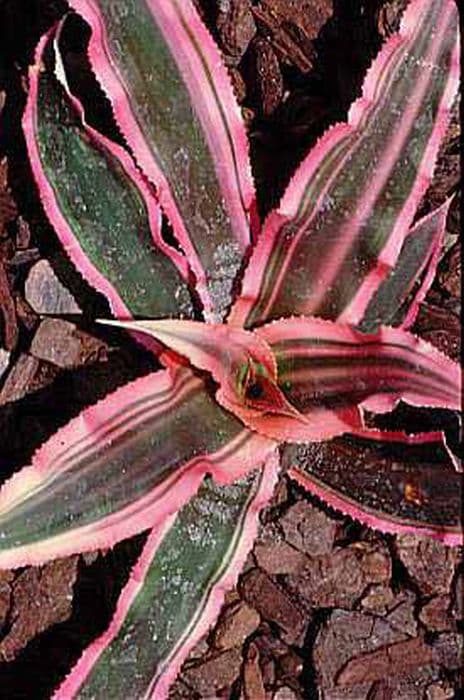Orlando Aechmea Aechmea orlandiana

ABOUT
The Aechmea orlandiana, commonly referred to as "Ensign," is a striking bromeliad with a rosette-forming habit. It boasts stiff, spiky leaves that are green with beautifully patterned, horizontal bands of dark brown or black, giving it a very distinctive appearance. The leaves often have serrated edges, which adds to the plant's overall textured look. Over time, the center of the rosette becomes a vibrant focal point as it brings forth a flower spike. The inflorescence is quite eye-catching, typically showing off bright colors like vibrant reds or pinks, contrasted with flower bracts that can be purple, blue, or other vivid hues depending on the variety. These bracts are stiff and may appear shiny or waxy, providing a splendid contrast to the foliage. The visual appeal of Ensign is further enhanced when it's in bloom as the contrasting colors of the foliage and inflorescence complement each other, creating a tropical display. Its aesthetic makes it a popular choice for those looking to add an exotic touch to their plant collections or interior spaces. While it's not in bloom, the plant's variegated leaves maintain its ornamental value, ensuring that it remains attractive throughout the year. Overall, the plant's unique combination of patterned leaves and brightly colored inflorescence makes it a favorite among enthusiasts who appreciate its ornate flair and eye-catching appearance.
About this plant
 Names
NamesFamily
Bromeliaceae
Synonyms
Fingernail Plant, Ensign Bromeliad, Orlandiana
Common names
Aechmea orlandiana
 Toxicity
ToxicityTo humans
Aechmea orlandiana, commonly known as the 'Ensign Bromeliad,' is not known to be toxic to humans. There are no significant reports of toxicity from ingesting or handling this ornamental plant. However, it is generally advised to avoid consuming parts of ornamental plants due to the uncertainty of their effects and potential individual allergies. In any case, if ingestion does occur and there is a negative reaction, medical attention should be sought.
To pets
Aechmea orlandiana, commonly known as the 'Ensign Bromeliad,' is not known to be toxic to pets. This ornamental plant does not appear on lists of plants commonly recognized as poisonous to domestic animals such as dogs and cats. Nevertheless, it is recommended to prevent pets from ingesting plants as a precautionary measure, and because individual animals may have unique sensitivities. If a pet ingests some of the Ensign Bromeliad and exhibits unusual symptoms, it is important to consult with a veterinarian.
 Characteristics
CharacteristicsLife cycle
Perennials
Foliage type
Evergreen
Color of leaves
Variegated
Flower color
Red
Height
1-2 feet (0.3-0.6 meters)
Spread
1-2 feet (0.3-0.6 meters)
Plant type
Bromeliad
Hardiness zones
10
Native area
Brazil
Benefits
 General Benefits
General Benefits- Decorative Appeal: Aechmea orlandiana, commonly known as Orlando Aechmea, has an attractive rosette of leaves and a striking inflorescence that adds aesthetic value to indoor and outdoor spaces.
- Low Maintenance: Orlando Aechmea is easy to care for, requiring minimal watering and feeding, which is ideal for those with busy lifestyles or unfamiliar with plant care.
- Drought Tolerance: Thanks to its water-storing abilities, Orlando Aechmea can survive periods of drought, making it suitable for xeriscaping and water-wise gardening.
- Long Blooming Period: The inflorescence of Orlando Aechmea lasts for several weeks to months, providing a long-lasting display of color and interest.
- Adaptability: Orlando Aechmea can adapt to a variety of environments, from low-light indoor conditions to brighter outdoor settings.
 Medical Properties
Medical PropertiesThis plant is not used for medical purposes.
 Air-purifying Qualities
Air-purifying QualitiesThis plant is not specifically known for air purifying qualities.
 Other Uses
Other Uses- The stiff leaves of Aechmea orlandiana can be used in the creation of small, decorative woven baskets or as natural adornments in floral arrangements for an exotic touch.
- In its native habitat, the durable leaves of Aechmea orlandiana have historically been used as makeshift roofing material for small shelters due to their resistance to decay and water.
- The bromeliad's unique structure and coloration can serve as inspiration for artists and designers, influencing patterns and textures in fabric or wallpaper designs.
- Aechmea orlandiana can be used educationally in botany or horticulture programs to demonstrate the diversity and adaptive strategies of epiphytic plants in tropical ecosystems.
- The plant can be a natural source of dye for textiles, with the bright bracts possibly providing pigment for sustainable, plant-based colorants.
- Gardeners might utilize the striking form of Aechmea orlandiana as a living sculpture to accentuate modern landscape designs and create focal points in gardens.
- This bromeliad can be a model organism for scientific research on CAM (Crassulacean Acid Metabolism) photosynthesis, which is a water-conserving process some plants use.
- Aechmea orlandiana's unique ability to store water in its central tank makes it a potential natural water collection system for small insects and animals during dry periods.
- Due to its robust nature, this plant is sometimes used in terrariums or paludariums to create miniature ecosystems or biotopes for observing interactions between flora and fauna.
- When dried, the sharp-edged leaves can serve as a natural form of protective layering against garden pests, deterring them from accessing more vulnerable plants.
Interesting Facts
 Feng Shui
Feng ShuiThe Aechmea is not used in Feng Shui practice.
 Zodiac Sign Compitability
Zodiac Sign CompitabilityThe Aechmea is not used in astrology practice.
 Plant Symbolism
Plant Symbolism- Protection: The spiky leaves of the Aechmea orlandiana, commonly known as the "Orlandiana," are often associated with protection, as they appear to shield and defend the delicate flower within.
- Strength and Resilience: This plant is known for its hardiness and ability to thrive in various conditions, symbolizing inner strength and the resilience to withstand challenges.
- Hospitality: Aechmea, as a member of the Bromeliad family, harkens back to the symbolism of the pineapple, which is a traditional emblem of hospitality and warm welcome.
- Uniqueness and Individuality: The striking appearance and unique beauty of the Orlandiana bloom can represent one's individuality and the celebration of standing out from the crowd.
 Water
WaterThe Orlandiana Bromeliad should be watered sparingly, aiming to keep the soil slightly moist but never soggy. Water the plant with approximately 6-8 ounces of water every week during the warmer months and reduce to around 4-6 ounces every two weeks during the cooler months. Ensure that water fills the central “tank” of the plant, which is the rosette-like part where the leaves meet and form a cup, as this mimics their natural rain-catching characteristic. Over-watering can lead to root rot, so it’s important to allow the top inch of soil to dry out before watering again. It is better to err on the side of under-watering than over-watering with Bromeliads.
 Light
LightThe Orlandiana Bromeliad thrives in bright, indirect light. It should be placed in a location where it can receive plenty of light but is shielded from direct, harsh sunlight, especially during the hottest part of the day. An east or west-facing window covered with a sheer curtain is often ideal. Too little light may result in the plant losing its vibrant colors, while too much direct light can scorch the leaves.
 Temperature
TemperatureThe Orlandiana Bromeliad prefers warm temperatures, thriving in a range between 60 to 80 degrees Fahrenheit. It can survive in temperatures as low as 40 degrees Fahrenheit, but it's not frost-tolerant and prolonged exposure to cold will damage the plant. The ideal temperature conditions for this Bromeliad are consistent, as drastic fluctuations can stress the plant.
 Pruning
PruningPruning the Orlandiana Bromeliad is primarily done to remove dead or dying leaves and to enhance the plant's appearance. Use clean, sharp scissors to cut the leaves at the base, and prune sparingly to avoid damaging the plant. The best time for pruning is during the active growing season when the plant can recover more easily from the loss of foliage. Bromeliads typically only flower once, so after the plant blooms, you can also prune the flower stalk, encouraging the plant to focus its energy on producing pups.
 Cleaning
CleaningAs needed
 Soil
SoilThe best soil mix for the Enchanted Forest Aechmea (Aechmea orlandiana) should be well-draining, with a mixture of orchid bark, perlite, and peat-based potting soil. The ideal soil pH for an Aechmea orlandiana is between 5.0 and 6.0 to mimic its native acidic conditions.
 Repotting
RepottingEnchanted Forest Aechmea should be repotted every two to three years or when it outgrows its container. It is best to repot it in the spring or early summer during its active growing period.
 Humidity & Misting
Humidity & MistingEnchanted Forest Aechmea thrives in high humidity levels, ideally between 50% and 70%. It benefits from the moisture in the air, replicating its native tropical environment.
 Suitable locations
Suitable locationsIndoor
Ensure bright indirect light, high humidity, and warm temps for Enchanted Forest Aechmea.
Outdoor
Plant in dappled shade, protect from frost, and maintain high humidity for Enchanted Forest Aechmea.
Hardiness zone
10-11 USDA
 Life cycle
Life cycleAechmea orlandiana, commonly known as Enchanted Forest, begins its life cycle with seed germination, which occurs in warm and humid conditions often found in tropical or subtropical environments. After germination, seedlings develop into juvenile plants with a rosette of spiny-edged leaves. Over time, the plant matures and the center of the rosette produces a striking inflorescence composed of colorful bracts and flowers, which is the reproductive stage. After pollination, often facilitated by birds or insects, the plant produces small berries containing seeds, completing the sexual reproduction cycle. Subsequently, the mother plant starts to decline and eventually dies, but before dying, it may produce offsets or "pups" around its base, which represent its vegetative propagation stage. These pups will grow, detach, and establish themselves as independent plants, continuing the survival of the species.
 Propogation
PropogationPropogation time
Spring to Summer
The most popular method of propagation for the Aechmea orlandiana, commonly known as Orlandiana, is by separating and planting its offsets, which are also known as "pups". These pups form around the base of the mother plant. The best time to propagate is during the late spring or early summer, when the plant is in its active growth phase. Carefully remove the pups from the mother plant when they are about one-third of the size of the parent. Make sure each pup has some roots attached. Plant them in a well-draining potting mix and keep them in a warm, humid environment with indirect sunlight to encourage root development and growth.









